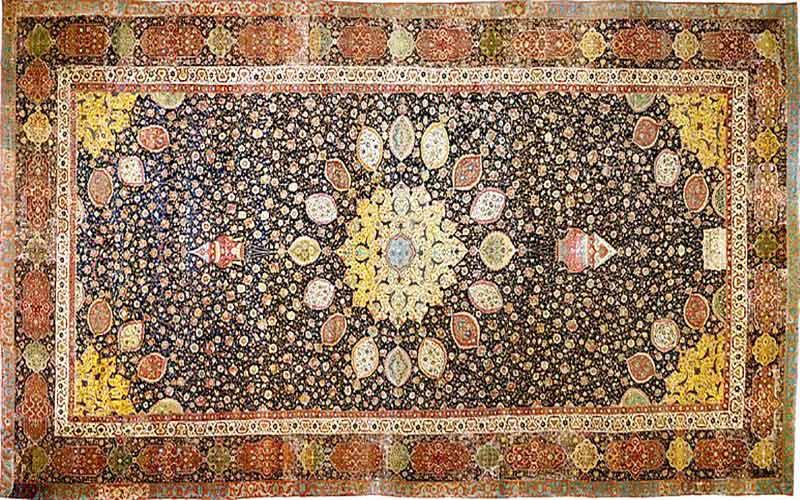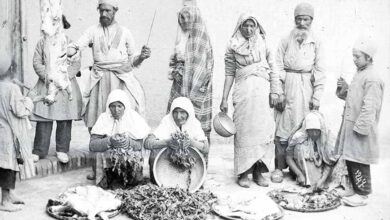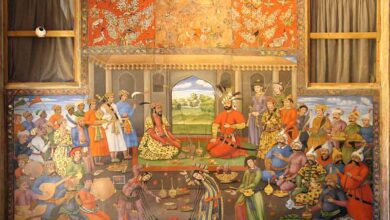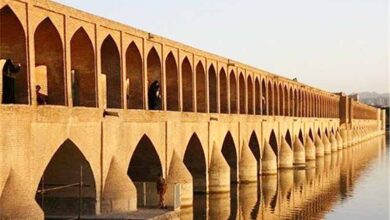Inscriptions Rugs

The handicrafts of people all over the world, of which Rug is an extract, show that nature has always inspired artists to create their works of art.
The cunning role of design artists by using Mamdouh and Mahmoud imaginations to the holy and heavenly worlds, the creator of unique and unparalleled works in the field of art is superior to others and the art of the East shines and also by using nature throughout the long history of Iranian carpets. He has given boundless gifts to the design and role of this handicraft. The art of calligraphy on the carpet reflects the reflection of Persian literature.
Iranian carpets with different designs have different themes and messages and are a symbol of original art and rich culture and literature of Iran. Engraving on the tools of the work, or on the wall of the place of residence has been common in Iran since the Achaemenid period and subsequent dynasties. Of course, in the Islamic period, due to the change of religion in Iran, changes also appeared in art.
The reason for the expansion of the line on objects and works can be considered as two main reasons. First, because in religions the appeal to prayer and recitation and belief in achieving goodness and blessings and happiness through prayer was firmly established, later in the new religion, people with faith almost on most of the tools and life of their lives painted the names of saints and religious leaders. And they sought help for blessings and happiness.
Second, as we know, Iranians were very interested in decorating their objects and tools. And because they could not use the role of the face, they resorted to the line. And they used calligraphy to decorate their works. And the prayers and hadiths, Pando Anders, engraved the poems in a beautiful handwriting on the bed of their works and life accessories. Hence, it can be seen that the artists have paid more attention to the beauty of the line and have created angles and shapes in its writing.
It should be said that calligraphy has become one of the elements of decorative arts in Iran during the Islamic period.
We begin with a variety of questions:
– What group of carpets are inscribed rugs?
– Why did they use calligraphy in rug?
– Are the shapes of the inscriptions on the rugs different in different areas?
– For example, in the city of Kerman, what form have they mostly used for inscriptions? And what about other areas?
– What kind of line have they used inside the inscription frame?
– In which part of the rug are the inscriptions made?
Carpet: It is an Arabic word and is said to be anything that can be spread. The Persian equivalent of rug is rug.
Rug: The current word rug has become common in the Pahlavi Persian pronunciation. According to some scholars, the word rug is derived from the lexical root (Qaliqiya or Qaliqila), which is the name of an imaginary city in the Caucasus.
The people of Kashmir use the original word alinKalin, which is the root of Rug.
The word Colin comes from the ancient form (Karayan) which is derived from the root (Kar) meaning planting, and it is right that the ancient Iranians considered planting a knot in the rug taropod as planting seeds and seedlings in the heart of the soil. Hence, they put a Ghalin or rug on it.
Inscription: An inscription written in different lines on the entrance of the wall of a building or on the body of a mountain. Some kind of frame role and more of a role in rectangles and rhombuses and the like.
The role of the inscription in the rug is sometimes used to write “poetry”, “history”, “texture” and “weaver’s name”, and sometimes this image has a decorative aspect.
Museum rug: It is a rug that, due to its antiquity, art, extraordinary quality of raw materials, design and texture, has the ability to be kept in a museum, which requires a lot of money.
Persian poetry and literary themes have always been the source of artistic inspiration for the men of this land over the course of a thousand years. Among the national arts, few art can be found that have not used ancient Persian literature. Iranian handicrafts, especially rug as one of the national arts, have not benefited from this effect.
In the classification of all Iranian rug designs, which are divided into at least twenty main groups, no group has been assigned to inscribed rugs. And perhaps this is because the name of the design given to the carpet ((for example, Shah Abbasi’s Islamic bergamot elastic) reflects the rug text design, and none of these terms can be understood in terms of its margin and design.
An overview of the Iranian rug
The artistic taste and creativity of any society is rooted and inspired by the life traditions and historical and environmental backgrounds of that people. And often this taste and talent is crystallized in one or more specific disciplines. One of the arts that has been perfected in this land over time, and the taste of the Iranian artist has been abundantly manifested in that area, is the art of carpet weaving.
The reason for this prosperity and excellence, in addition to the inherent characteristics of Iranians such as art-loving and tolerance, should be considered in the abundance of raw materials for rug production, such as high-quality wool and various types of colored plants.
The carpets used by early humans for bedding, bedding, cargo, tomb coverings, animal coverings, etc. were made from the bark and leaves of trees and animal skins. It is the nature of the critic and the hand of the human artist who, throughout its history, has brought about the evolution of the textile and weaving industry to such an extent that the handicrafts of today’s artists amaze the viewer in every way and dazzle the eyes. Undoubtedly, the use of bedding dates back to the time when man thought of building a shelter to provide his comfort.
In 1949, Professor Rodenko discovered a knotted rug, originally used as a horse cover, in tombs hidden in the ice of nomadic nomads in a place called Pazyryk, 80 km from the Mongolian border. The carpet, which dates back to the 4th and 5th centuries BC, is woven in the size of 200 × 183 cm with 3600 knots per square decimeter in copper brown and light green.
Its marginal images are very similar to the common shapes in the Achaemenid period and the designs of Persepolis. And in the central background, the image of a four-pointed star can be seen, which is exactly similar to the shapes that exist on the objects discovered in Lorestan related to this period. According to the theory of a famous researcher named Dimand, a combination of Assyrian, Achaemenid and Scythian designs has been used in the Pazyryk carpet. He believes that the origin of this carpet is from Iran.
Historical evidence confirms that rug weaving flourished during the Sassanid era. In connection with this, the Chinese yearbook Sui Su, dating to 617-590 AD, shortly before the extinction of the Sassanid dynasty, mentions rug among Iranian goods.
One of the famous rugs of this period is the rug of Bahar Khosrow, which is also mentioned in the history book of Tabari (311-225 AH) as follows:
“… that there was an excellent rug made in Iran called Bahar Khosrow in Ctesiphon Palace, 450 feet long and 90 feet wide …”
The rug was named because its role represented a garden adorned with flowers, birds and flowing water. There are two opinions about this expensive rug:
One is that when Khosrow Parviz, the Sassanid king, was defeated by the Roman emperor Heraclius, this carpet fell into the hands of the dominant armies. Another view is that this is the famous rug of “Baharestan” which was plundered by the Arab armies in the defeat of Yazdgerd III, the last Sassanid king.
In the book Hudood Al-Alam, materials have been written that confirm the weaving of carpets in the Persian region in the third century AH.
In Professor Pope’s view, a careful study of the early rugs may be the best introduction to Iranian industry.
In the Shahnameh, the esteemed poet Ferdowsi mentions the carpet as one of the gifts that the king of Kabul sends to Sam, Zal’s father:
And that rags of Indian planners loaded all four garments and carpets
The Post Islamic Era
Iranian carpet weaving stagnated somewhat in the early days of Arab rule. Because the Arabs, unlike the art of pottery in which they excelled, did not attach much importance to the art of carpet weaving for racial or climatic reasons in any of their historical periods.
The cessation of this profession and craft continued only until the time of the luxurious Umayyad and Abbasid caliphs, who did not need the beautiful and exquisite rug of Iran in decorating their legendary palaces. In this period, historical books in the description of gifts and gifts of local rulers for the Umayyad and Abbasid caliphs, repeatedly mention the Iranian rug. The Seljuk Turks conquered a large area of Iran in the year (416 AH) in 1037 and settled in Azerbaijan and the central and western regions of Iran. And with this invasion, their language and culture were also brought to this land. And mingled with Iranian art and culture. As a result, the rug designs of Iran in this cultural encounter are influenced by the Seljuk designs. Considering the fact that there is no significant effect of the Iranian rugs of this period today, its role cannot be properly drawn. However, it can be said with caution that the designs of the rugs of this time were with broken lines and without curvature, and also the delicacy of their texture did not reach the woven base in later periods.
This growing prosperity continued until the Mongol invasion, and with the invasion of the Mongol armies, carpet weaving, like other artistic activities, ceased for a time.
During the reign of Timur Lang in this land, many of the artistic features of Iran underwent fundamental changes, and regarding the role of the carpet, the resulting changes were such that geometric designs gradually gave way to designs with rotating and curved lines and motifs such as ivy and flowers. Fan palms, cloud masses, all kinds of mythical and ordinary animals and birds, etc. are included in Iranian carpet designs. The art of carpet weaving becomes extremely perfect and important at the end of the Timurid rule. It is speculated that the rugs attributed to the early Safavid period were probably woven in Tabriz at this time. During the Safavid period, the art of carpet weaving reached its peak of prosperity, prosperity and perfection. The rug designs of the creativity and ingenuity of the artists of this era are so fertile that after a few hundred years they are still imitated. The carpet weavers of this period have left about 1,500 carpets and rugs using this design, some of which have been registered as the masterpieces of carpet weaving in the world, which now adorn the museums and collections of the world. It is in this period that carpet weaving changes from a rural and nomadic profession to an important profession in urban workshops and trade and export to European countries begins. In this period, the main centers of carpet weaving are the cities of Isfahan, Kashan, Tabriz and Kerman. And its designs are divided into the following groups: bergamot, vase, hunting ground, Herati flower, tree and shrub, garden, Polish.
In the last years of the Safavid dynasty until the rise of Afghanistan, which led to the extinction of this dynasty, little attention was paid to the art of carpet weaving.
It is only in the last period of the Qajar dynasty that carpet weaving was revived and continued satisfactorily.
Late Qajar period and the first two decades of the fourteenth century AH, high demand for Iranian rug and its successful trade caused a large number of foreign companies from countries such as Britain, America, Switzerland, Greece, etc. to invest in Iranian rug and Mass production was encouraged and some of the most important and exquisite carpets in Iran were woven in the same period and by the order of these companies in cities such as Kerman, Arak, Hamedan, Tabriz and Mashhad. Among these companies, the largest and richest were the American company Atieh Boros, the Swiss company / English Ziegler, the Italian company Nircocastelli Brothers, Taushehandchian, Petak, Kazan Carpet and partners, the largest and richest, the richest and richest producers in the East. In Iran, it is also known as the East London Company and was owned by the British and was owned by none other than Cecil Edwards, the famous carpet expert. In 1314 Shamsi, with the expropriation of Shargh Company, the authority to carry out production and commercial activities of Iran rug was transferred to a newly established government institution called Iran Carpet Joint Stock Company. Trade it pay.
* Sources and references are available in the editorial office of Artmag.









